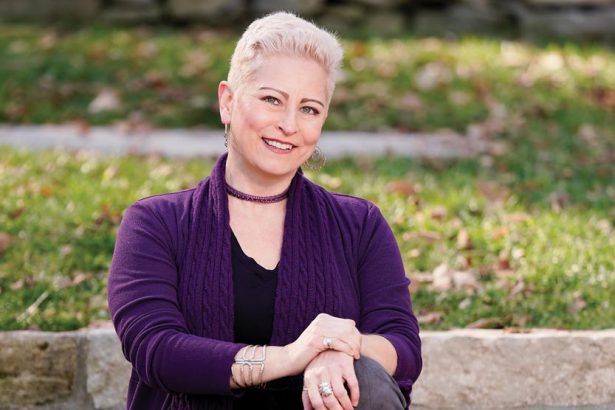Patient Search
 |
 |
|
KaCrole Higgins was diagnosed with breast cancer in 2020. “In May 2020, I found a lump in my breast. I cried. By June, it was diagnosed as breast cancer, triple positive, stage 1A. While getting this cancer diagnosis was devastating, it also became an opportunity. Suddenly, the cancer gave me clarity. It gave me clarity about what was important, what was good in my life, what was toxic in my life, and what I needed to do.” Click below to read more of KaCrole’s story |
If Landon Ryan had been diagnosed with bilateral retinoblastoma 10, 20 or 30 years ago, she might not be here today with nearly perfect vision.Thanks to recent improvements in the treatment for this rare form of cancer that almost exclusively affects children under the age of 5, the diagnosis had the power to change Landon’s life when she was 11 months old, but not to take it — or her eyesight. Click below to learn more about Landon and her story. https://momentum.vicc.org/2022/04/brighter-outlook/ |
A Trial Comparing Unrelated Donor BMT With IST for Pediatric and Young Adult Patients With Severe Aplastic Anemia (TransIT, BMT CTN 2202)
Pediatrics
Pediatrics
Severe Aplastic Anemia (SAA) is a rare condition in which the body stops producing enough new
blood cells. SAA can be cured with immune suppressive therapy or a bone marrow transplant.
Regular treatment for patients with aplastic anemia who have a matched sibling (brother or
sister), or family donor is a bone marrow transplant. Patients without a matched family donor
normally are treated with immune suppressive therapy (IST). Match unrelated donor (URD) bone
marrow transplant (BMT) is used as a secondary treatment in patients who did not get better
with IST, had their disease come back, or a new worse disease replaced it (like leukemia).
This trial will compare time from randomization to failure of treatment or death from any
cause of IST versus URD BMT when used as initial therapy to treat SAA.
The trial will also assess whether health-related quality of life and early markers of
fertility differ between those randomized to URD BMT or IST, as well as assess the presence
of marrow failure-related genes and presence of gene mutations associated with MDS or
leukemia and the change in gene signatures after treatment in both study arms.
This study treatment does not include any investigational drugs. The medicines and procedures
in this study are standard for treatment of SAA.
blood cells. SAA can be cured with immune suppressive therapy or a bone marrow transplant.
Regular treatment for patients with aplastic anemia who have a matched sibling (brother or
sister), or family donor is a bone marrow transplant. Patients without a matched family donor
normally are treated with immune suppressive therapy (IST). Match unrelated donor (URD) bone
marrow transplant (BMT) is used as a secondary treatment in patients who did not get better
with IST, had their disease come back, or a new worse disease replaced it (like leukemia).
This trial will compare time from randomization to failure of treatment or death from any
cause of IST versus URD BMT when used as initial therapy to treat SAA.
The trial will also assess whether health-related quality of life and early markers of
fertility differ between those randomized to URD BMT or IST, as well as assess the presence
of marrow failure-related genes and presence of gene mutations associated with MDS or
leukemia and the change in gene signatures after treatment in both study arms.
This study treatment does not include any investigational drugs. The medicines and procedures
in this study are standard for treatment of SAA.
Pediatrics
III
Connelly, James
NCT05600426
VICCPED2295
LCH-IV, International Collaborative Treatment Protocol for Children and Adolescents With Langerhans Cell Histiocytosis
Multiple Cancer Types
The LCH-IV is an international, multicenter, prospective clinical study for pediatric
Langerhans Cell Histiocytosis LCH (age < 18 years).
Langerhans Cell Histiocytosis LCH (age < 18 years).
Miscellaneous,
Pediatrics
III
Pastakia, Devang
NCT02205762
VICCPED2231
Venetoclax in Children With Relapsed Acute Myeloid Leukemia (AML)
Multiple Cancer Types
A study to evaluate if the randomized addition of venetoclax to a chemotherapy backbone
(fludarabine/cytarabine/gemtuzumab ozogamicin [GO]) improves survival of
children/adolescents/young adults with acute myeloid leukemia (AML) in 1st relapse who are
unable to receive additional anthracyclines, or in 2nd relapse.
(fludarabine/cytarabine/gemtuzumab ozogamicin [GO]) improves survival of
children/adolescents/young adults with acute myeloid leukemia (AML) in 1st relapse who are
unable to receive additional anthracyclines, or in 2nd relapse.
Pediatric Leukemia,
Pediatrics
III
Smith, Christine
NCT05183035
VICCPED2237
A Study of the Drugs Selumetinib vs. Carboplatin and Vincristine in Patients with Low-Grade Glioma
Multiple Cancer Types
This phase III trial compares the effect of selumetinib versus the standard of care treatment with carboplatin and vincristine (CV) in treating patients with newly diagnosed or previously untreated low-grade glioma (LGG) that does not have a genetic abnormality called BRAFV600E mutation and is not associated with systemic neurofibromatosis type 1. Selumetinib works by blocking some of the enzymes needed for cell growth and may kill tumor cells. Carboplatin and vincristine are chemotherapy drugs that work in different ways to stop the growth of tumor cells, either by killing the cells or by stopping them from dividing. The overall goal of this study is to see if selumetinib works just as well as the standard treatment of CV for patients with LGG. Another goal of this study is to compare the effects of selumetinib versus CV in subjects with LGG to find out which is better. Additionally, this trial will also examine if treatment with selumetinib improves the quality of life for subjects who take it.
Neuro-Oncology,
Pediatrics
III
Pastakia, Devang
NCT04166409
COGACNS1833



